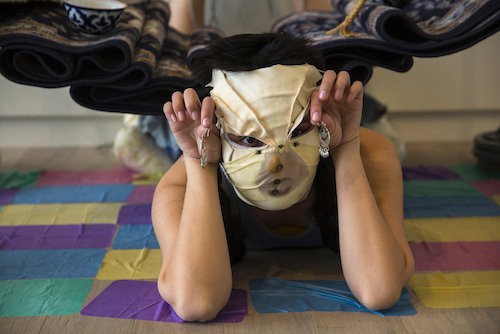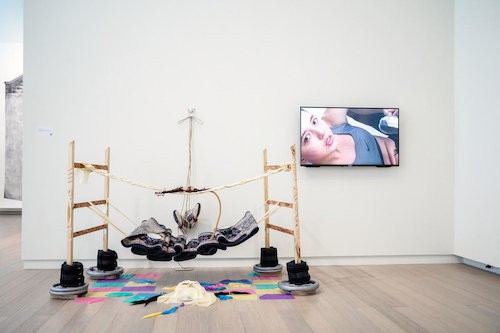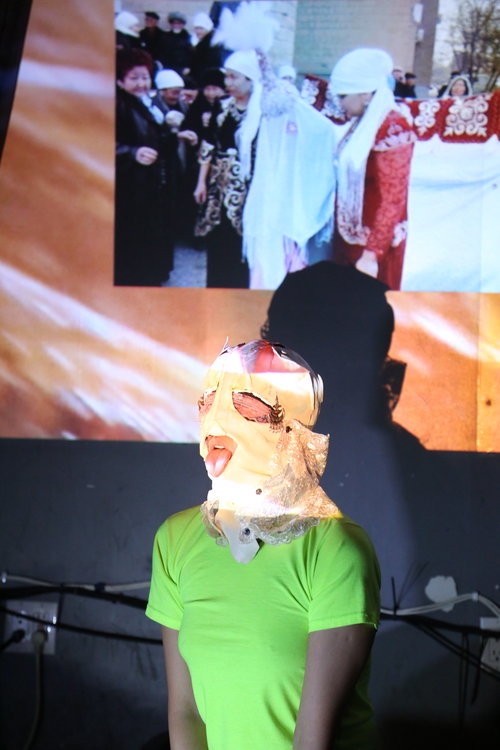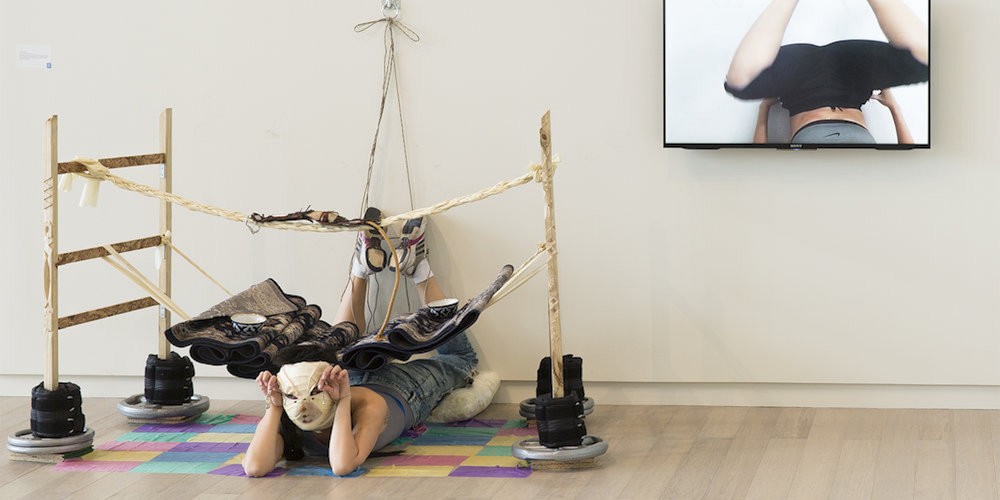Conversations with Artists in Art Getting Art: Aika Akhmetova '20
Conversations with Artists in Art Getting Art is a bi-weekly series and a play on Jerry Seinfeld's Comedians in Cars Getting Coffee. We interview artists about their art and 'getting art'. This week we sat down with Aika Akhmetova '20 to talk about performance art, their entry into performance art at RISD, and what they are discovering about themselves and their body’s place in the world through performance art.
Aika Akhmetova is a second-year student in New Genres. Their work is a combination of sculpture and performance, and fearlessly combines the two to create sometimes whimsical, sometimes eerie works of performance art. In one, they try to lick their own foot, playing with the idea of those who lick others’ feet in a form of worship. In trying to lick their own foot, they become both the worshipped and the worshipper.
Akhmetova graduated from RISD in 2017, where they studied painting. While at RISD, they took a course which asked students to “perform” the RISD museum, and there, Akhmetova performed one of their first works of performance art, in a half-broken elevator, reciting a manual while brushing their teeth. What excites Akhmetova about this art form today is the possibility it allows the artist to feel things. Each new work pushes a different sensorial experience, almost to its limit. More recently, they covered themselves with apples. Their studio is now filled with apples, and smells of apples, and feels, I hope, of autumn.
When I visited your website, the first image I saw featured a sculpture with a human sort of underneath it. Could you tell me what that is? Was that your most recent work?
Aika Akhmetova: That was my first year showpiece, so it wasn’t my most recent one—I’m pretty bad at updating my website. It was a sculpture activated by the performer, and I was laying under the sculpture for about three hours. It’s called Kyzdin Zholy Zheneshke.
I also saw something with a dog.
AA: Dog’s Growl?
Yes, that! What kind of work is this? It’s silly to think about genres, but I guess for the sake of, I don’t know, canons, it’s fun to see where one might fit.
AA: I guess for the two you described, they could be called performances. The first one would be called a performance with sculpture as residue, and the second one, Dog’s Growl, that is a performance. I mean it had a video element and I made a mask for the performance, but I think these would be performances.
How would you define performance art? Could it be the act of painting, the act of sculpture?
AA: It could be. Sometimes there are performances that later result in a physical thing, like a drawing or a sculpture. I don’t know, there are many types of performances. It’s hard to define it. When I think of performance, I classify it into categories. One is where there is nothing left after the performance. It’s a thing that happened at a certain point in time, and it might’ve been documented. But that’s it. There’s no other trace of anything. Or there’s performance that makes something. So over the course of the performance, you’re making a physical thing, you’re leaving a physical thing. Then there’s a performance with props, like a performance which activates a sculpture, and it remains.
So before you got to Columbia, I saw you were at RISD. How was that?
AA: It was very different. It was undergrad, and I studied painting, so that was also really different. It felt like a conservative school in a certain sense, when it comes to art and art-making. I was taught there was a right way to do something and a wrong way to do something. And I was in the painting department, and I thought the painting department would be the most flexible in terms of doing something else, because I was interested in installation, performance, video. And I was able to do that there, but I found that my peers weren’t super excited or interested or had much to say about my work. Critiques were very different. It was always me explaining why I decided to do that instead of paint that. It was always about painting—just paint it.
Could you give me an example of this sort of mindset?
AA: Well, I would make like a little installation which would include fruits and some broken-down furniture, and some stuff that I painted on, taped, and printed out photographs, and during the whole course of the crit, it would be people saying “I don’t understand.” Basically implying they don’t see the value or work in this. Which is to me such an unproductive way to talk about art. To start by saying “Well, how much time did you spend on this?” It’s such a silly concept.
That’s rather old-fashioned.
AA: And it’s funny because usually I would spend a lot of time on it, but if you move an object from one place to another there is no trace of you having moved the object or people seeing that you did the work, and I guess in painting and drawing, you sometimes do see the “work.” The discussions weren’t going anywhere most of the time.
How do you feel about the program at Columbia? How are the critiques?
AA: I think it’s very different. And if I’m comparing it to RISD it’s amazing. I applied to Columbia through New Genres, so I’m not in any department, but I usually have crits from professors of different disciplines.
What kinds of classes do you take for New Genres?
AA: There’s isn’t really a class. I wish there was though.
What would this class look like?
AA: I don’t know, I think it could be multiple classes, because New Genres is supposed to encompass whatever doesn’t fit into the traditional ways of making art. I guess I see New Genres as performance and sculpture but everything in between, like social work. Our program doesn’t offer many courses—well, there’s one performance course a year. I thought, when I applied to New Genres—and I hadn’t heard the term New Genres but I’d heard of new media—that it would be more new media-like, involving technology in art making. I just assumed that it would be something I would need to learn really fast, but it hasn’t been like that at all.
What do you mean by that?
AA: New Genres is just a name. There aren’t a lot of classes with mission statements to define the department or what it is. There isn’t enough full-time faculty in the department to help develop the future of the department.
I guess in a way this allows for more individuality. Having no overarching class, students can perhaps take more liberties.
AA: The whole program is interdisciplinary, so we have access to every single one of the professors. I think we have great professors in our program. I really enjoy working with Shelly Silver. She’s a moving image professor, she does video work, but I got a lot out of her class. There’s also Gabo Camnitzer, a sculpture professor. There’s a lot, if we’re not talking about full-time faculty, like Maren Hassinger, who’s been very helpful with my work. She’s a performer. Every time she’s in my studio, I start to understand the value of having someone in your discipline, talking about your discipline. She brings up so many different little things that I don’t think about.
What kinds of things?
AA: I was doing a performance where I was covering myself in apples, and emerging from the apples, and she was telling me, “Get a cushion for your head.” She’s concerned about the body and the impact of performances on the body. For the first year, she told me to get a pillow to lie on to not crush my ribs, because I was in the sculpture for three-and-a-half hours.
You covered yourself in apples! What did that look like? What did that smell like?
AA: I got a box, I cut a hole in the box, and I laid there while my friends covered me in apples. I was also wearing a ball gag. It was a performance for video, so I had the video camera over me. It’s not on my website yet, it’s a work in progress. I’m still shooting it.
So I guess my next question is: some performances are for the video camera, and some are for live audiences, and some are for—some third category?
AA: What do you mean?
Who else is a performance for? Or what else? Who is it supposed to reach, and through what medium?
AA: Like the audience? It’s for everyone, but I think there are performances that you do by yourself in a closed room and you do some time of documentation. You take pictures, a video, so that other people can see it. But while you perform, there’s no one else in the room. There are also performances with audiences that are also videotaped. Personally, with the apples, I don’t see the value of a big audience standing there, watching me buried by apples. It was a fast thing, it took about five minutes.
Did you start with no apples in the box, to getting completely covered with apples? Zero apples to apples. What did that feel like?
AA: It was funny because performances feel a lot more intense than they are sometimes. For me, because I was wearing a ball gag and I was in a box, and the room was completely dark, and I just had lighting on me for the video, it felt pretty claustrophobic. I was in a box. I was covered in apples. I couldn’t move. And with the ball gag, there’s this sense of restraint, and the apples, the weight of apples on my body, that added to the sense of restraint. It felt interesting. There was also the smell of apples, overwhelmingly apples.
Could I ask how you developed this piece?
AA: Sure. I’m still working on it, because it’s supposed to be three parts, like three TV screens with different videos. The first one is my face, the second one is my belly, the third one is my feet, and it’s all being covered with apples, then getting out of the apples. I had this idea a while ago because my mom, she grows apples for a living. She has an apple orchard. I feel like I see big amounts of apples, I saw a big pile of apples in my mom’s orchard, and I thought it could be cool to perform with it somehow. I could bury myself in them. I couldn’t do that with my mom’s apples, so I recreated it here.
What happened to the apples afterwards?
AA: I gave a lot of them away. Some of them are still in my studio. They’re starting to go bad now. I might have to eat them or cook them. They will rot. I just have to get them out of my studio.
Smell might be the surprising element that differentiates performance art from other art. How do you incorporate smell in your work?
AA: You saw in that first piece, on my website—the floor is lined with dental dams. They have a very overwhelming smell. I think with a lot of people in the room, it’s harder to smell it, but I could. You know, someone told me that they thought I was a mannequin, which I thought was funny, because it kind of defeats the purpose—not entirely—but if you think it’s a mannequin then you take one glance at it and look away, because you perceive that thing to be still. But I was inside of it, and I was moving around it. I’m not sure how people interacted with it.
So where is this apple orchard?
AA: (Laughs.) I’m from Kazakhstan. My mom’s orchard is just outside the main city.
Nice. What were you up to in Kazakhstan?
AA: I was a child, I was growing up. I went to school, I was very serious about music at the time. I played piano. But at a certain point, I realized I didn’t want to do that for a living, so I started thinking about what I wanted to do. I thought I’d be a journalist, because I wanted to study in Moscow, and my mom was really against me going. So I didn’t do that. My dad gave me his old camera and I started taking pictures, and then—see, this isn’t an inspiring story.
There’s no such thing as an inspiring story. Or, rather: every story is inspiring in its own right.
AA: So I had my dad’s camera and I was really into taking pictures. When my mom asked me what I was thinking about doing after school, I told her, maybe architecture, because I seem to like taking pictures of buildings. So I started looking at architecture school, and realized I needed to learn to draw, so I learned to draw. Then I came to RISD. The first year is your foundation year. Everyone told me to not go into architecture because I’m not that good at math. I don’t have a great 3D understanding of the world, so I ended up in painting.
Can you remember your first work of performance art? Did it have to do with painting, or the act of painting?
AA: I think it was a class called “Performing the Museum” with Jane Saul. It was a class in collaboration with the RISD museum, responding to the museum. My first performance was as assignment for that class. I was in an elevator that was under construction. There was a part of the museum under construction, but you could still use the elevator, and there would be workers there. So I had a bathmat on the floor, and I was dressed in something that looked like pajamas, and I was barefoot, walking on the bathmat, and I was brushing my teeth and reciting Maintenance Manifesto by Mierle Laderman Ukeles. I did it for the entire day.
What excites you about performance art?
AA: Some, not all, my performances involve interacting with objects. That first-year showpiece, for instance, left a sculpture that lived on without me. I like the feeling that I gain something from performance art. When you perform, you have a very different experience than the people looking at you. And a lot of the times my performances are pretty visceral, or deal with my body feeling something. For my first year showpiece, because I was on the ground. I watched people’s feet for three hours while having this overwhelming scent of latex. That was an experience. I can remember what I smelled, I can remember what I saw. And I like that. It kind of feels like a little secret between me and my work. It made me excited to do the next thing. How can I feel next? What can I smell next?
That sounds playful. This kind of performance art feels so fun, like you jab at your different senses and ask what are you up to? Which brings me to my next question: what impact does having a live audience or camera have on your work?
AA: In my case, a lot of the time, what happens on camera or what happens in my work, is submissive. And the viewer is dominant, watching. I was also thinking about the idea of practicing on yourself, and practicing submission on yourself. It feels like a snake biting its tail, because in the act of licking your foot, you are both dominant and submissive. It has this idea of childhood and self-exploration, but also play.
Who are some artists you admire?
AA: I really like the work of Maren Hassinger. I’m a big fan of Anna Madeira. A lot of what she [Madeira] does is extremely visceral. I only know their works through their photos, how they have been documented. and those pictures were beautiful. You see, now I’m blanking on everything. Actually, you know, we actually had Nic Kay come in, and I really like their work. Their work has a lot more to do with choreography.
Performance Art stills from Aika Akhmetova '20
Image Carousel with 3 slides
A carousel is a rotating set of images. Use the previous and next buttons to change the displayed slide
-
Slide 1: Still from Kyzdin Zholy Zheneshke, performance art piece by Aika Akhmetova '20, image courtesy of the artist
-
Slide 2: Still from Kyzdin Zholy Zheneshke, performance art piece by Aika Akhmetova '20, image courtesy of the artist
-
Slide 3: Still from Kyzdin Zholy Zheneshke, performance art piece by Aika Akhmetova '20, image courtesy of the artist



